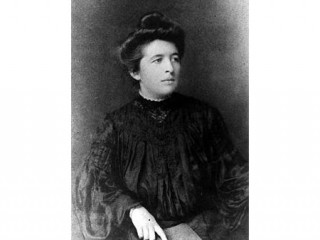
Dorothy Reed Mendenhall biography
Date of birth : 1874-09-22
Date of death : 1964-07-31
Birthplace : Columbus, Ohio
Nationality : American
Category : Science and Technology
Last modified : 2011-03-07
Credited as : Medical researcher, obstetrician, discoverer of the Reed-Sternberg cell
Dorothy Reed Mendenhall was a well-respected researcher, obstetrician, and pioneer in methods of childbirth. She was the first to discover that Hodgkin's disease was actually not a form of tuberculosis, a finding that received international acclaim.
As a result of her work, the cell type characteristic of Hodgkin's disease bears Mendenhall's name. The loss of her first child due to poor obstetrics changed her research career to a lifelong effort to reduce infant mortality rates. Mendenhall's efforts paid off with standards being set for weight and height for children ages birth to six, and also in programs that stressed the health of both the mother and child in the birthing process.
Dorothy Reed Mendenhall, the last of three children, was born September 22, 1874, in Columbus, Ohio, to William Pratt Reed, a shoe manufacturer, and Grace Kimball Reed, both of whom had descended from English settlers who came to America in the seventeenth century. Mendenhall attended Smith College and obtained a baccalaureate degree. Although she initially contemplated a career in journalism, Mendenhall's interest in medicine was inspired by a biology course she attended.
When they opened the school up to women, Mendenhall applied to Johns Hopkins Medical School in Baltimore, Maryland. In 1900, she was one of the first women to graduate from this school with a doctorate of medicine degree. The next year she received a fellowship in pathology at Johns Hopkins. While there, she taught bacteriology and performed research on Hodgkin's disease, which physicians then believed was a form of tuberculosis. She disproved this theory when she discovered a common link between diagnosed patients. She found that the blood of these patients carried a specific type of cell. The presence of these giant cells, now known as the Reed cell, distinctly identifies the disease. Mendenhall's work produced the first thorough descriptions, both verbal and illustrated, of the tissue changes that occur with Hodgkin's. She was the first to describe the disease's growth through several progressive states. Mendenhall determined that a patient's prognosis worsened with each successive stage. She incorrectly speculated, however, that the disease was a chronic inflammatory process. Her finding of the distinctive cell had worldwide importance and was a significant step forward in the understanding and treatment of Hodgkin's disease. Today, researchers know that Hodgkin's is a type of cancer characterized by a progressive enlargement of the lymph nodes.
Because she felt that there were few opportunities for advancement at Johns Hopkins, Mendenhall transferred her work to Babies Hospital of New York, becoming the first resident physician there. In 1906, she married Charles Elwood Mendenhall and began to raise a family. She had four children, one who died a few hours after birth. This loss was to shape the rest of her career. Mendenhall undertook a study of infant mortality, that, when released, brought government attention to the problems of maternal and child health. To determine the extent of infant mortality in the United States, she obtained epidemiological data for the Wisconsin State Board of Health. A major problem she identified was the prevalence of malnutrition among children. In her efforts to remedy the problems of childbearing and childrearing, Mendenhall developed correspondence courses for new and prospective mothers. She also lectured to groups across Wisconsin and wrote bulletins on nutrition for the United States Department of Agriculture. Mendenhall's efforts helped create some of Wisconsin's first infant welfare clinics, particularly in Madison. In 1937, she was gratified when Madison had the lowest infant mortality rate in the United States.
While employed as a field lecturer for the Department of Home Economics at the University of Wisconsin, in 1918, Mendenhall initiated a nationwide effort in which all children under six years of age were weighed and measured. This project helped establish standards for that normal, healthy children of these ages should weigh and how tall they should be. In 1926, Mendenhall undertook a study of birthing methods in Denmark, which had one of the lowest rates of childbirth complications. She later travelled to the country to gain firsthand information on their techniques, which included the utilization of specialized midwives and a reduced role of medical procedures. Through this, Mendenhall determined that there was too much medical intervention in normal childbirth, and that this intervention is often the source of health problems for the mother and child. She helped institute natural childbirth in the U.S. and also suggested that obstetrics become a specialty profession. From 1917 to 1936, Mendenhall also worked intermittently as a medical officer for the United States Children's Bureau. After her husband's death, she withdrew from public life. In her spare time she loved to read Marcus Aurelius. As a tribute to her dedication as a researcher, teacher, and physician, Smith College dedicated Sabin-Reed Hall in 1965. The hall honors Mendenhall and Florence Sabin, a fellow student at both Smith and Johns Hopkins. Mendenhall died July 31, 1964, in Chester, Connecticut, from heart disease.
















